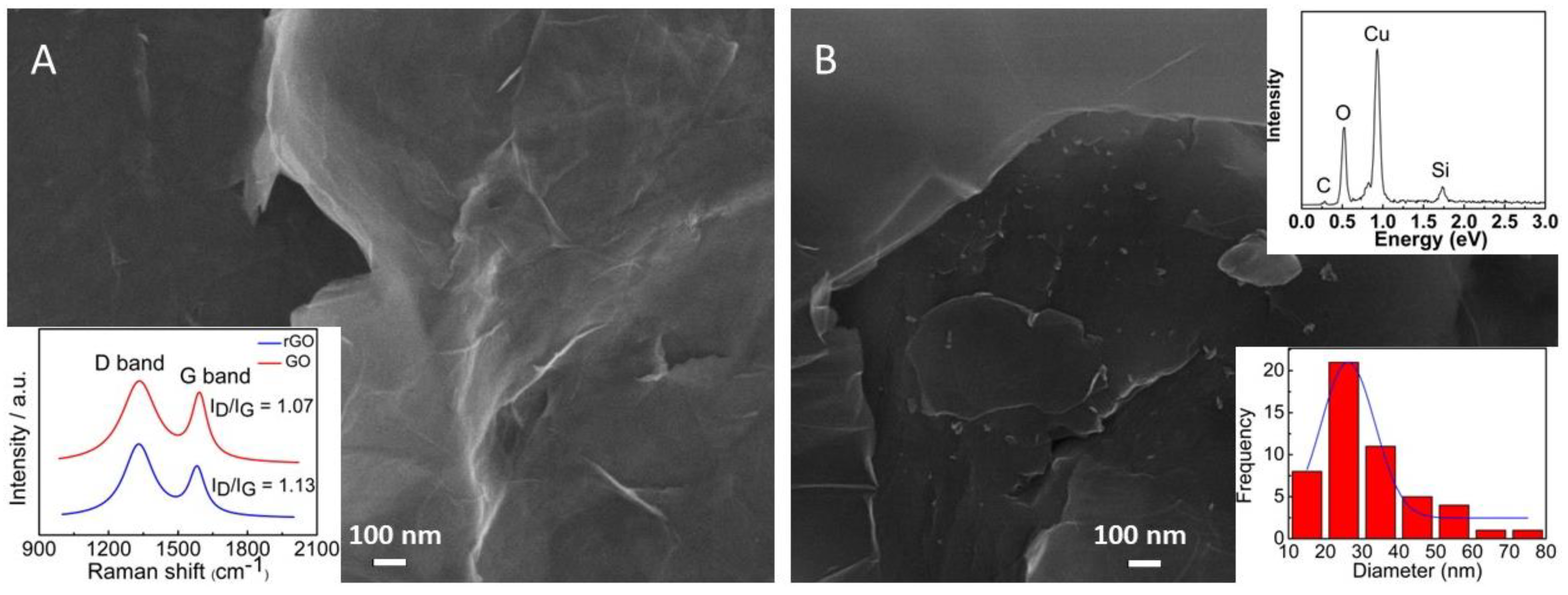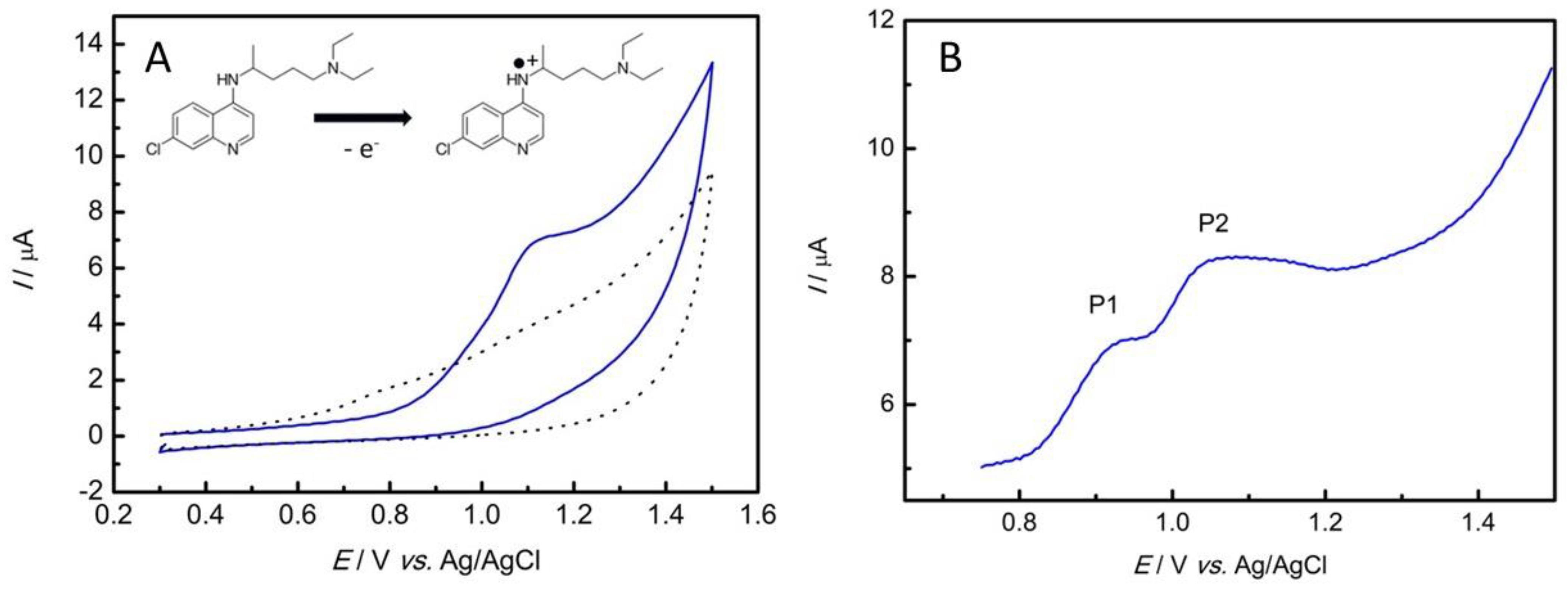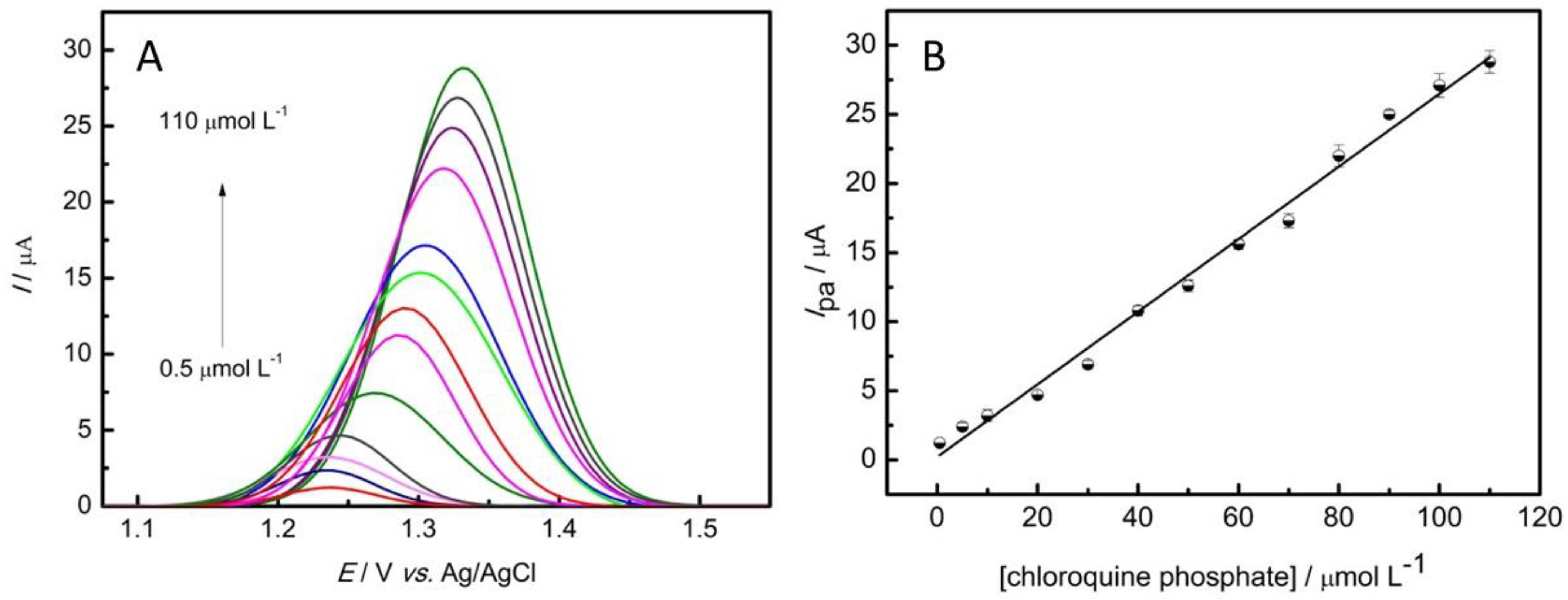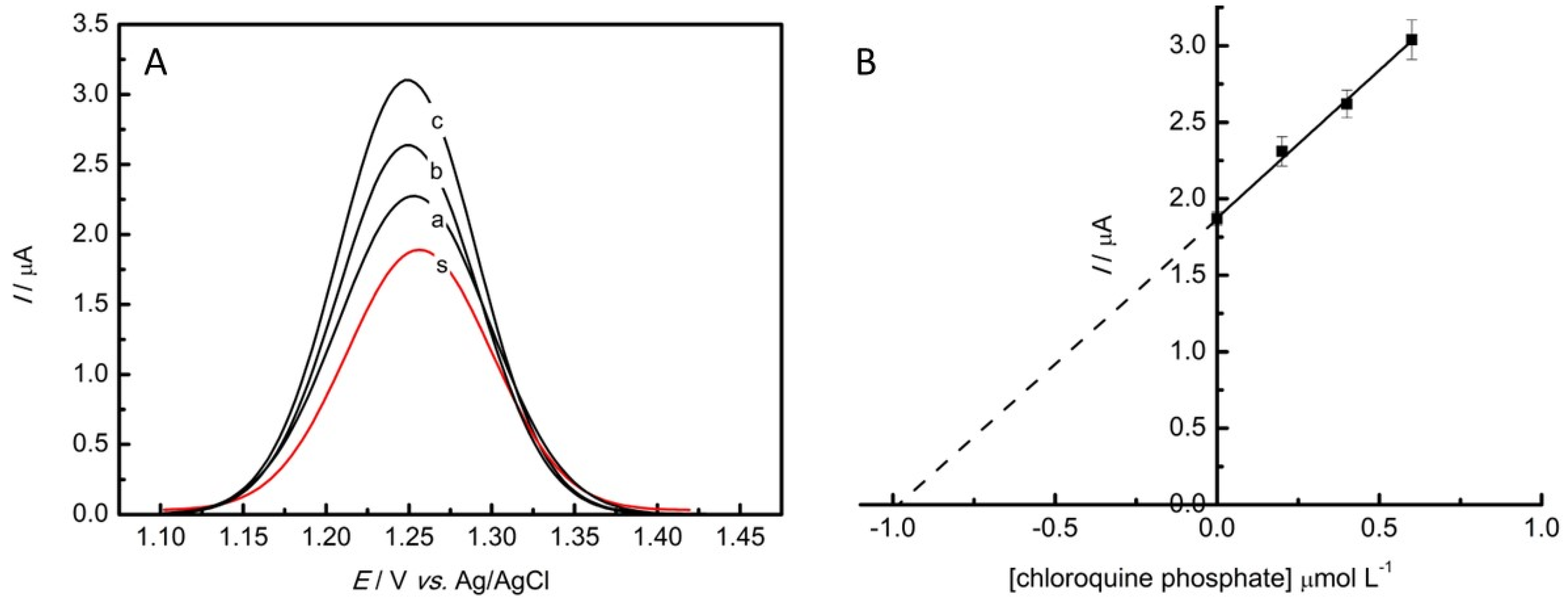Copper Nanoparticles and Reduced Graphene Oxide as an Electrode Modifier for the Development of an Electrochemical Sensing Platform for Chloroquine Phosphate Determination
Abstract
1. Introduction
2. Materials and Methods
2.1. Instrumentation
2.2. Solutions and Reagents
2.3. Synthesis of Reduced Graphene Oxide (rGO)
2.4. Synthesis of Reduced Graphene Oxide with Copper Nanoparticles (rGO-CuNPs)
2.5. Electrode Preparation
2.6. Sample Preparation and Analysis of Chloroquine Phosphate in Tap Water
3. Results and Discussion
3.1. Morphological and Electrochemical Characterization of the Materials
3.2. Evaluation of the Electrochemical Behavior for the Different Working Electrodes
3.3. Electrochemical Behavior of the GC/rGO-CuNPs Sensor during the Chloroquine Phosphate Oxidation Process
3.4. Optimized Parameters
3.5. Analytical Characteristics
3.6. Determination of Chloroquine Phosphate in Tap Water
3.7. Determination of Chloroquine Phosphate in the Presence of Other Analytes
4. Conclusions
Author Contributions
Funding
Data Availability Statement
Conflicts of Interest
References
- Koçak, B.; Ipek, Y. Electrochemical Detection of Ivermectin Used for the Treatment of COVID-19 with Glutardialdehyde-Modified Glassy Carbon Electrode. Electrocatalysis 2022, 13, 108–115. [Google Scholar] [CrossRef]
- de Araújo, D.M.; Paiva, S.D.S.M.; Henrique, J.M.M.; Martínez-Huitle, C.A.; Dos Santos, E.V. Green Composite Sensor for Monitoring Hydroxychloroquine in Different Water Matrix. Materials 2021, 14, 4990. [Google Scholar] [CrossRef] [PubMed]
- Dong, F.; Li, J.; Lin, Q.; Wang, D.; Li, C.; Shen, Y.; Zeng, T.; Song, S. Oxidation of chloroquine drug by ferrate: Kinetics, reaction mechanism and antibacterial activity. Chem. Eng. J. 2022, 428, 131408. [Google Scholar] [CrossRef]
- Rahimi, R.; Solimannejad, M.; Farghadani, M. Adsorption of chloroquine and hydroxychloroquine as potential drugs for SARS-CoV-2 infection on BC3 nanosheets: A DFT study. New J. Chem. 2021, 45, 17976–17983. [Google Scholar] [CrossRef]
- Zurita, J.L.; Jos, A.; del Peso, A.; Salguero, M.; López-Artíguez, M.; Repetto, G. Ecotoxicological evaluation of the antimalarial drug chloroquine. Aquat. Toxicol. 2005, 75, 97–107. [Google Scholar] [CrossRef]
- Farias, D.F.; Souza, T.; Souza, J.A.C.R.; Vieira, L.R.; Muniz, M.S.; Martins, R.X.; Gonçalves, F.S.; Pereira, E.A.S.; Maia, M.E.S.; Silva, M.G.F. COVID-19 Therapies in Brazil: Should We Be Concerned with the Impacts on Aquatic Wildlife? Environ. Toxicol. Chem. 2020, 39, 2348–2350. [Google Scholar] [CrossRef]
- Gupta, N.; Kumar, P.; Kamal, S.; Tuli, S. COVID-19 and manifest psychological morbidity: A case series. Indian J. Psychiatry 2021, 63, 294–296. [Google Scholar] [CrossRef]
- Kumari, M.; Kumar, A. Can pharmaceutical drugs used to treat Covid-19 infection leads to human health risk? A hypothetical study to identify potential risk. Sci. Total Environ. 2021, 778, 146303. [Google Scholar] [CrossRef] [PubMed]
- Tarazona, J.V.; Martínez, M.; Martínez, M.-A.; Anadón, A. Environmental impact assessment of COVID-19 therapeutic solutions. A prospective analysis. Sci. Total Environ. 2021, 778, 146257. [Google Scholar] [CrossRef] [PubMed]
- Usman, M.; Farrukh, M.A. Delayed release profile of iron nano-chloroquine phosphate and evaluation of its toxicity. Mater. Today Proc. 2018, 5, 15645–15652. [Google Scholar] [CrossRef]
- Usman, M.; Farrukh, M.A. Formulation of polymeric iron nano-chloroquine phosphate anti-malarial drug via polyol method. Mater. Today Proc. 2018, 5, 15595–15602. [Google Scholar] [CrossRef]
- Kashyap, A.; Kaur, R.; Baldi, A.; Jain, U.K.; Chandra, R.; Madan, J. Chloroquine diphosphate bearing dextran nanoparticles augmented drug delivery and overwhelmed drug resistance in Plasmodium falciparum parasites. Int. J. Biol. Macromol. 2018, 114, 161–168. [Google Scholar] [CrossRef]
- Magalhaes, G.A., Jr.; Neto, E.M.; Sombra, V.G.; Richter, A.R.; Abreu, C.M.W.S.; Feitosa, J.P.A.; Paula, H.C.B.; Goycoole, F.M.; de Paula, R.C.M. Chitosan/Sterculia striata polysaccharides nanocomplex as a potential chloroquine drug release device. Int. J. Biol. Macromol. 2016, 88, 244–253. [Google Scholar] [CrossRef] [PubMed]
- Escande, C.; Chevalier, P.; Verdier, F.; Bourdon, R. Sensitive Radioimmunoassay and Enzyme-Linked Immunosorbent Assay for the Simultaneous Determination of Chloroquine and Its Metabolites in Biological Fluids. J. Pharm. Sci. 1990, 79, 23–27. [Google Scholar] [CrossRef]
- Churchill, F.C.; Mount, D.L.; Schwartz, I.K. Determination of chloroquine and its major metabolite in blood using perfluoroacylation followed by fused-silica capillary gas chromatography with nitrogen-sensitive detection. J. Chromatogr. B Biomed. Sci. Appl. 1983, 274, 111–120. [Google Scholar] [CrossRef] [PubMed]
- Dongre, V.G.; Ghugare, P.D.; Karmuse, P.; Singh, D.; Jadhav, A.; Kumar, A. Identification and characterization of process related impurities in chloroquine and hydroxychloroquine by LC/IT/MS, LC/TOF/MS and NMR. J. Pharm. Biomed. Anal. 2009, 49, 873–879. [Google Scholar] [CrossRef]
- Idowu, O.; Ajayi, F.; Salako, L. Specific spectrofluorimetric determination of chloroquine in blood plasma. Anal. Chim. Acta 1988, 206, 345–349. [Google Scholar] [CrossRef]
- Huang, Y.; Pan, W.; Guo, M.; Yao, S. Capillary electrophoresis with end-column electrochemiluminescence for the analysis of chloroquine phosphate and the study on its interaction with human serum albumin. J. Chromatogr. A 2007, 1154, 373–378. [Google Scholar] [CrossRef] [PubMed]
- Guo, D.; He, R.; Su, W.; Liang, Z.; Zhang, W.; Fan, J. Enantioselective analyses of chloroquine and hydroxychloroquine in rat liver microsomes through chiral liquid chromatography–tandem mass spectrometry. Chirality 2022, 34, 126–133. [Google Scholar] [CrossRef]
- Bilgin, Z.D.; Evcil, I.; Yazgi, D.; Binay, G.; Genc, C.O.; Gulsen, B.; Huseynova, A.; Ozdemir, A.Z.; Ozmen, E.; Usta, Y.; et al. Liquid Chromatographic Methods for COVID-19 Drugs, Hydroxychloroquine and Chloroquine. J. Chromatogr. Sci. 2021, 59, 748–757. [Google Scholar] [CrossRef]
- Sok, V.; Marzan, F.; Gingrich, D.; Aweeka, F.; Huang, L. Development and validation of an LC-MS/MS method for determination of hydroxychloroquine, its two metabolites, and azithromycin in EDTA-treated human plasma. PLoS ONE 2021, 16, e0247356. [Google Scholar] [CrossRef]
- Martins, Y.A.; Gonçalves, T.M.; Lopez, R.F.V. HPLC methods for choloroquine determination in biological samples and pharmaceutical products. DARU J. Pharm. Sci. 2021, 29, 223–239. [Google Scholar] [CrossRef]
- Maciel, T.R.; Pacheco, C.D.O.; Ramos, P.F.; Ribeiro, A.C.F.; dos Santos, R.B.; Haas, S.E. Simultaneous determination of chloroquine and colchicine co-nanoencapsulated by HPLC-DAD. J. Appl. Pharm. Sci. 2023, 13, 106–112. [Google Scholar] [CrossRef]
- Shamshad, H.; Sayqal, A.; Zeb, J.; Mirza, A.Z. Simultaneous Determination of Chloroquine and Pyrimethamine with Cetirizine in an Active Form and Human Serum by RP-HPLC. J. Chromatogr. Sci. 2021, 59, 923–927. [Google Scholar] [CrossRef]
- Tegegne, B.; Chandravanshi, B.S.; Zewge, F.; Pillay, L.; Chimuka, L. Development and validation of a single HPLC method for the determination of thirteen pharmaceuticals in bulk and tablet dosage form. Bull. Chem. Soc. Ethiop. 2021, 35, 17–31. [Google Scholar] [CrossRef]
- Tegegne, B.; Chandravanshi, B.S.; Zewge, F.; Chimuka, L. Solid-phase optimisation for simultaneous determination of thirteen pharmaceuticals in Ethiopian water samples with HPLC-DAD detection: An initial assessment. Environ. Monit. Assess. 2021, 193, 310. [Google Scholar] [CrossRef]
- Kanvinde, S.; Chhonker, Y.S.; Ahmad, R.; Yu, F.; Sleightholm, R.; Tang, W.; Jaramillo, L.; Chen, Y.; Sheinin, Y.; Li, J.; et al. Pharmacokinetics and efficacy of orally administered polymeric chloroquine as macromolecular drug in the treatment of inflammatory bowel disease. Acta Biomater. 2018, 82, 158–170. [Google Scholar] [CrossRef]
- Imran, M.; Ashiq, M.Z.; Shafi, H.; Usman, H.F.; Wattoo, S.A.; Sarwar, M.; Tahir, M.A. Hair analysis of an unusual case of Chloroquine intoxication. Leg. Med. 2016, 19, 5–10. [Google Scholar] [CrossRef] [PubMed]
- Gomes, G.C.; da Silva, M.K.L.; Barreto, F.C.; Cesarino, I. Electrochemical Sensing Platform Based on Renewable Carbon Modified with Antimony Nanoparticles for Methylparaben Detection in Personal Care Products. Chemosensors 2023, 11, 141. [Google Scholar] [CrossRef]
- Cesarino, I.; Cincotto, F.H.; Machado, S.A. A synergistic combination of reduced graphene oxide and antimony nanoparticles for estriol hormone detection. Sens. Actuators B Chem. 2015, 210, 453–459. [Google Scholar] [CrossRef]
- Couto, R.A.S.; Lima, J.L.F.C.; Quinaz, M.B. Recent developments, characteristics and potential applications of screen-printed electrodes in pharmaceutical and biological analysis. Talanta 2016, 146, 801–814. [Google Scholar] [CrossRef] [PubMed]
- Naik, K.M.; Nandibewoor, S.T. Electroanalytical method for the determination of methylparaben. Sens. Actuators A Phys. 2014, 212, 127–132. [Google Scholar] [CrossRef]
- Donini, C.A.; da Silva, M.K.L.; Simões, R.P.; Cesarino, I. Reduced graphene oxide modified with silver nanoparticles for the electrochemical detection of estriol. J. Electroanal. Chem. 2018, 809, 67–73. [Google Scholar] [CrossRef]
- Fernandes, V.Q.; Silva, M.K.L.; Cesarino, I. Determination of isotretinoin (13-cis-retinoic acid) using a sensor based on reduced graphene oxide modified with copper nanoparticles. J. Electroanal. Chem. 2020, 856, 113692. [Google Scholar] [CrossRef]
- Barreto, F.C.; Silva, M.K.L.; Cesarino, I. An Electrochemical Sensor Based on Reduced Graphene Oxide and Copper Nanoparticles for Monitoring Estriol Levels in Water Samples after Bioremediation. Chemosensors 2022, 10, 395. [Google Scholar] [CrossRef]
- Tung, T.T.; Nine, M.J.; Krebsz, M.; Pasinszki, T.; Coghlan, C.J.; Tran, D.N.H.; Losic, D. Recent Advances in Sensing Applications of Graphene Assemblies and Their Composites. Adv. Funct. Mater. 2017, 27, 1702891. [Google Scholar] [CrossRef]
- Cesarino, I.; Simões, R.P.; Lavarda, F.C.; Batagin-Neto, A. Electrochemical oxidation of sulfamethazine on a glassy carbon electrode modified with graphene and gold nanoparticles. Electrochim. Acta 2016, 192, 8–14. [Google Scholar] [CrossRef]
- Golinelli, D.L.; Machado, S.A.; Cesarino, I. Synthesis of Silver Nanoparticle-Graphene Composites for Electroanalysis Applications using Chemical and Electrochemical Methods. Electroanalysis 2017, 29, 1014–1021. [Google Scholar] [CrossRef]
- Shabani-Nooshabadi, M.; Roostaee, M. Modification of carbon paste electrode with NiO/graphene oxide nanocomposite and ionic liquids for fabrication of high sensitive voltammetric sensor on sulfamethoxazole analysis. J. Mol. Liq. 2016, 220, 329–333. [Google Scholar] [CrossRef]
- Li, J.; Kuang, D.; Feng, Y.; Zhang, F.; Xu, Z.; Liu, M.; Wang, D. Green synthesis of silver nanoparticles–graphene oxide nanocomposite and its application in electrochemical sensing oftryptophan. Biosens. Bioelectron. 2013, 42, 198–206. [Google Scholar] [CrossRef]
- Setznagl, S.; Cesarino, I. Copper nanoparticles and reduced graphene oxide modified a glassy carbon electrode for the determination of glyphosate in water samples. Int. J. Environ. Anal. Chem. 2022, 102, 293–305. [Google Scholar] [CrossRef]
- AbdelHamid, A.; Elgamouz, A.; Khanfer, M.; Kawde, A.-N. COVID-19 chloroquine drug detection using novel, highly sensitive SnO2-based electrochemical sensor. Arab. J. Chem. 2023, 16, 104674. [Google Scholar] [CrossRef]
- Silva, M.K.L.; Sousa, G.S.; Simoes, R.P.; Cesarino, I. Fabrication of paper-based analytical devices using a PLA 3D-printed stencil for electrochemical determination of chloroquine and escitalopram. J. Solid State Electrochem. 2022, 26, 581–586. [Google Scholar] [CrossRef]
- Arguelho, M.L.P.; Andrade, J.F.; Stradiotto, N.R. Electrochemical study of hydroxychloroquine and its determination in plaquenil by differential pulse voltammetry. J. Pharm. Biomed. Anal. 2003, 32, 269–275. [Google Scholar] [CrossRef]
- George, J.M.; Mathew, B. Cyclodextrin-mediated gold nanoparticles as multisensing probe for the selective detection of hydroxychloroquine drug. Korean J. Chem. Eng. 2021, 38, 624–634. [Google Scholar] [CrossRef] [PubMed]
- Oliveira, G.G.; Azzi, D.C.; Silva, T.A.; de Oliveira, P.R.; Fatibello-Filho, O.; Janegitz, B.C. Sensitive Voltammetric Detection of Chloroquine Drug by Applying a Boron-Doped Diamond Electrode. C 2020, 6, 75. [Google Scholar] [CrossRef]
- Mashhadizadeh, M.H.; Akbarian, M. Voltammetric determination of some anti-malarial drugs using a carbon paste electrode modified with Cu(OH)2 nano-wire. Talanta 2009, 78, 1440–1445. [Google Scholar] [CrossRef]






| Parameters | Optimization Range | Optimized Values |
|---|---|---|
| Pre-concentration (V) | −1.2–−0.8 | −1.2 |
| rGO-CuNP concentration (mg/mL) | 0.01−0.10 | 0.04 |
| pH | 5−9 | 5 |
| Electrodes | Method | Linear Range (μmol L−1) | LOD (μmol L−1) | Analyte | Ref. |
|---|---|---|---|---|---|
| ePADs | DPV | 5−75 | 4.0 | Chloroquine | [43] |
| GrRAC | DPV | 5−65 | 1.05 | Hydroxychloroquine | [2] |
| Glassy carbon | DPV | 35−100 | 0.336 | Hydroxychloroquine | [44] |
| β-CD-AuNP | DPV | 0.01−0.05 | 0.00085 | Hydroxychloroquine | [45] |
| SnO2/graphite | SWV | 0.1–23.3 | 0.01 | Chloroquine phosphate | [42] |
| rGO-CuNPs | SWV | 0.5−110 | 0.23 | Chloroquine phosphate | This work |
| Repetition | Phosphate Chloroquine (μmol L−1) a | Relative Errors (%) b |
|---|---|---|
| 1 | 1.062 | 6.2 |
| 2 | 1.050 | 5 |
| 3 | 0.979 | −2.1 |
| Mean ± SD | 1.030 ± 0.037 |
| Interferent | Concentration (μmol L−1) | % Chloroquine Phosphate Signal |
|---|---|---|
| Estriol | 0.5 | 92.6 |
| 1.0 | 92.4 | |
| 1.5 | 91.2 | |
| Methylparaben | 0.5 | 96.4 |
| 1.0 | 91.2 | |
| 1.5 | 90.3 |
Disclaimer/Publisher’s Note: The statements, opinions and data contained in all publications are solely those of the individual author(s) and contributor(s) and not of MDPI and/or the editor(s). MDPI and/or the editor(s) disclaim responsibility for any injury to people or property resulting from any ideas, methods, instructions or products referred to in the content. |
© 2023 by the authors. Licensee MDPI, Basel, Switzerland. This article is an open access article distributed under the terms and conditions of the Creative Commons Attribution (CC BY) license (https://creativecommons.org/licenses/by/4.0/).
Share and Cite
Barreto, F.C.; da Silva, M.K.L.; Cesarino, I. Copper Nanoparticles and Reduced Graphene Oxide as an Electrode Modifier for the Development of an Electrochemical Sensing Platform for Chloroquine Phosphate Determination. Nanomaterials 2023, 13, 1436. https://doi.org/10.3390/nano13091436
Barreto FC, da Silva MKL, Cesarino I. Copper Nanoparticles and Reduced Graphene Oxide as an Electrode Modifier for the Development of an Electrochemical Sensing Platform for Chloroquine Phosphate Determination. Nanomaterials. 2023; 13(9):1436. https://doi.org/10.3390/nano13091436
Chicago/Turabian StyleBarreto, Francisco Contini, Martin Kássio Leme da Silva, and Ivana Cesarino. 2023. "Copper Nanoparticles and Reduced Graphene Oxide as an Electrode Modifier for the Development of an Electrochemical Sensing Platform for Chloroquine Phosphate Determination" Nanomaterials 13, no. 9: 1436. https://doi.org/10.3390/nano13091436
APA StyleBarreto, F. C., da Silva, M. K. L., & Cesarino, I. (2023). Copper Nanoparticles and Reduced Graphene Oxide as an Electrode Modifier for the Development of an Electrochemical Sensing Platform for Chloroquine Phosphate Determination. Nanomaterials, 13(9), 1436. https://doi.org/10.3390/nano13091436









